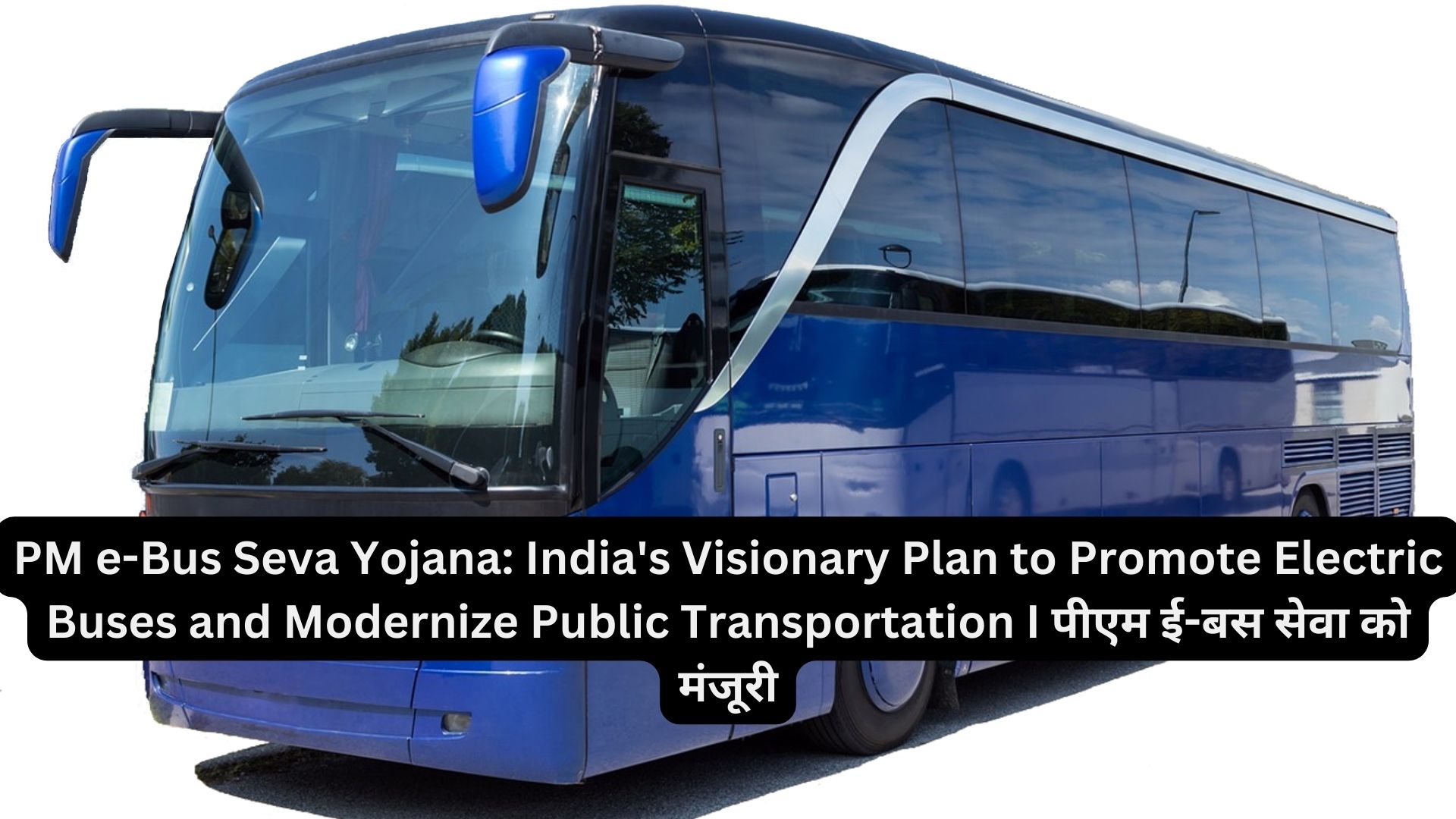
In a time where environmental concerns and the impact of climate change are at the forefront of global discussions, the Indian government has made the promotion of electric vehicles a top priority. To spearhead this initiative, the Central Government has launched the PM e-Bus Seva Scheme.
This groundbreaking scheme, approved during a cabinet meeting presided over by Prime Minister Narendra Modi, represents a significant leap towards advancing sustainable and eco-friendly transportation while combating climate change. The scheme’s ambitious goal is to set in motion 10,000 electric buses across the nation, with the potential to create employment opportunities for an estimated 45,000 to 55,000 individuals. This article serves as your comprehensive guide to the PM e-Bus Seva Yojana, shedding light on its objectives, advantages, and eligibility criteria.
What is PM e-Bus Seva?
The PM e-Bus Seva Scheme received approval from the Union Cabinet on August 16, 2023. This approval underscores the government’s unwavering commitment to promoting the use of electric vehicles in public transportation services. This visionary scheme aims to foster the widespread adoption of electric vehicles throughout the country.
Under this initiative, the Central Government has earmarked an impressive budget of Rs 57,613 crore for the operation of 10,000 electric buses nationwide. Furthermore, as part of the Green Urban Mobility Initiative, this scheme will promote the rapid expansion of bus transport networks, facilitate bike-sharing programs, and create dedicated cycle lanes, thereby encouraging the adoption of all types of electric vehicles.
Financial Support and Contribution:
Union Minister Anurag Thakur has revealed that, out of the overall budget of Rs 57,613 crore designated for the PM e-Bus Seva Yojana, a significant portion of Rs 20,000 crore will be furnished by the Central Government. The remaining funds will be sourced from state governments. This financial support is intended to stimulate the uptake of electric vehicles and foster employment prospects for the general populace. For comprehensive guidelines on the PM e-Bus Seva Yojana, you can access the official website of the Ministry of Housing and Urban Affairs at https://mohua.gov.in/.
Objective of PM e-Bus Seva Yojana:
The primary objective of the PM e-Bus Seva Yojana is to revamp transportation infrastructure in 181 cities as part of the Green Urban Mobility initiative. This transformation will be achieved through the deployment of 10,000 electric buses across 169 cities throughout the country. The government also intends to provide the essential infrastructure required for the operation of these buses. Additionally, various facilities designed for e-bus operators will be constructed and provided by the government. The overarching goal is to encourage the widespread use of electric vehicles and create employment opportunities.
Cities Covered Under PM e-Bus Seva:
The PM e-Bus Seva Yojana will encompass the operation of 10,000 electric buses in 169 cities across India. While the specific cities that will receive electric buses initially have not been disclosed, they will be selected through a challenge-based selection process. The scheme gives priority to cities with populations exceeding 3 lakhs and also focuses on areas that lack organized bus services.
Employment Generation:
This scheme operates under a public-private partnership model and will be in effect until 2037. It is anticipated that the scheme will directly provide employment to an estimated 45,000 to 55,000 individuals, thereby addressing the pressing issue of unemployment in the country. Furthermore, the Green Urban Mobility initiative aims to introduce non-motorized infrastructure, including bike-sharing programs, dedicated cycle lanes, and bus rapid transport projects. Additionally, new facilities such as the National Common Mobility Card, Intelligent Transit Management System, and Multi-Modal Interchanges will be initiated to enhance transportation services.
Benefits and Features of PM e-Bus Seva Scheme:
- Estimated cost of Rs 57,613 crore, with a significant contribution of Rs 20,000 crore from the Central Government.
- Support for the operation of buses for a decade, resulting in reduced carbon emissions.
- Coverage of cities with populations exceeding 3 lakhs.
- Inclusion of capital cities, union territories, North East states, and hill stations.
- Priority given to cities without organized bus services.
- Support provided to bus operators in 169 cities, along with the operation of e-buses in 181 new cities.
- Subsidies provided by the Central Government through the State Government.
- Deployment of approximately 10,000 new electric buses nationwide.
- Public-private partnership model in operation until 2037.
- Promotion of electric vehicle usage for a more environmentally friendly future.
Eligibility for PM e-Bus Seva:
-
-
- To be eligible for the benefits of the PM e-Bus Seva Yojana, applicants must meet the following criteria:
- Indian citizenship.
- Possession of a valid driving license.
- Access to roads and transportation infrastructure.
- The PM e-Bus Seva Scheme represents a visionary endeavor that not only promotes green mobility but also addresses the critical issue of unemployment in the country. By encouraging the adoption of electric vehicles and modernizing public transportation, it represents a significant step towards a cleaner, more sustainable future for India.
-
Read More
PM Suraksha Bima Yojana I प्रधानमंत्री सुरक्षा बीमा योजना (पीएमएसबीवाई)
What is PM SHRI Yojana : Know How 14,500 Schools Will Be Upgraded I पीएम श्री योजना क्या है
PM e-Bus Seva FAQs
What is the PM e-Bus Seva Scheme and when was it approved?
The PM e-Bus Seva Scheme is a government initiative approved on August 16, 2023, with the aim of promoting the use of electric vehicles in public transportation services.
What is the primary objective of the PM e-Bus Seva Yojana?
The primary objective of the PM e-Bus Seva Yojana is to revamp transportation infrastructure in 181 cities under the Green Urban Mobility initiative. This will be achieved by deploying 10,000 electric buses across 169 cities throughout the country.
How will the PM e-Bus Seva Scheme be funded?
The Central Government has allocated a budget of Rs 57,613 crore for the PM e-Bus Seva Scheme. Out of this, a significant sum of Rs 20,000 crore will be provided by the Central Government, while the remaining amount will be contributed by state governments.
Which cities will be covered under the PM e-Bus Seva Yojana?
The PM e-Bus Seva Yojana will encompass the operation of 10,000 electric buses in 169 cities across India. The specific cities where electric buses will be introduced will be selected through a challenge-based selection process. Priority will be given to cities with populations exceeding 3 lakhs and areas lacking organized bus services.
How long will the PM e-Bus Seva Scheme operate, and what is its employment potential?
The scheme operates under a public-private partnership model and will continue until 2037. It is expected to provide direct employment to an estimated 45,000 to 55,000 individuals, addressing the issue of unemployment in the country.
What are some key benefits and features of the PM e-Bus Seva Scheme?
Some key features include an estimated cost of Rs 57,613 crore, support for bus operations for a decade to reduce carbon emissions, coverage of cities with populations exceeding 3 lakhs, and a public-private partnership model in operation until 2037.
How does the PM e-Bus Seva Scheme promote green mobility?
The scheme encourages the adoption of electric vehicles, which are more environmentally friendly and reduce carbon emissions, thus contributing to green mobility.
Who is eligible to benefit from the PM e-Bus Seva Yojana?
To avail the benefits of the PM e-Bus Seva Yojana, applicants must be Indian citizens, possess a valid driving license, and have access to roads and transportation infrastructure.
What is the role of the Central Government in funding the PM e-Bus Seva Scheme?
The Central Government is set to provide a substantial sum of Rs 20,000 crore as financial support for the scheme, while state governments will contribute the remaining amount.
How does the PM e-Bus Seva Scheme contribute to addressing climate change?
By promoting electric vehicles and reducing carbon emissions, the scheme plays a significant role in combating climate change and advancing sustainable and eco-friendly transportation in India.
